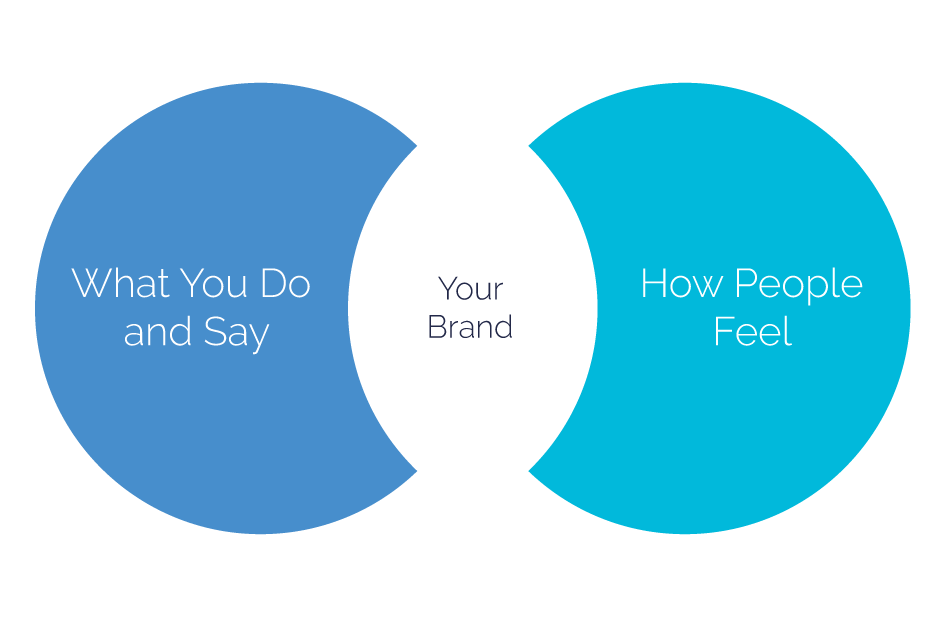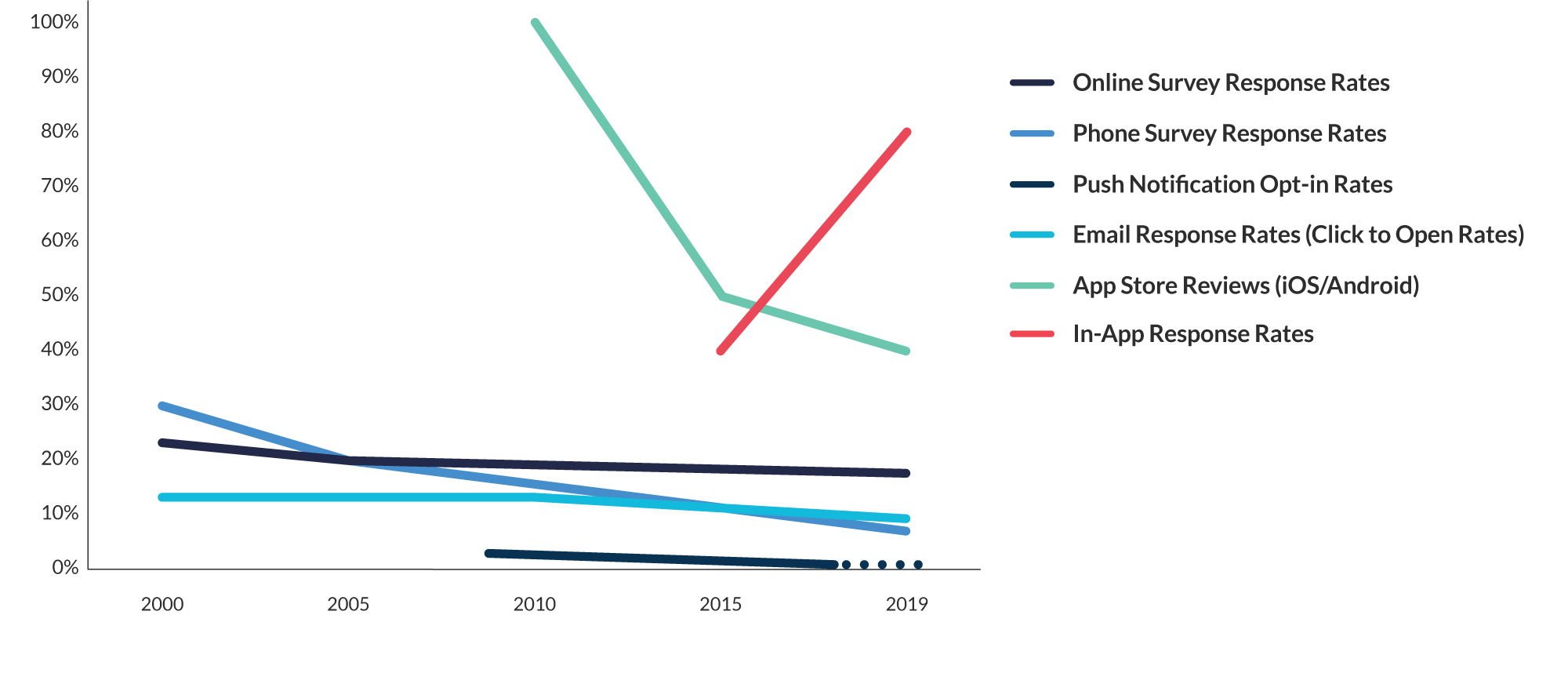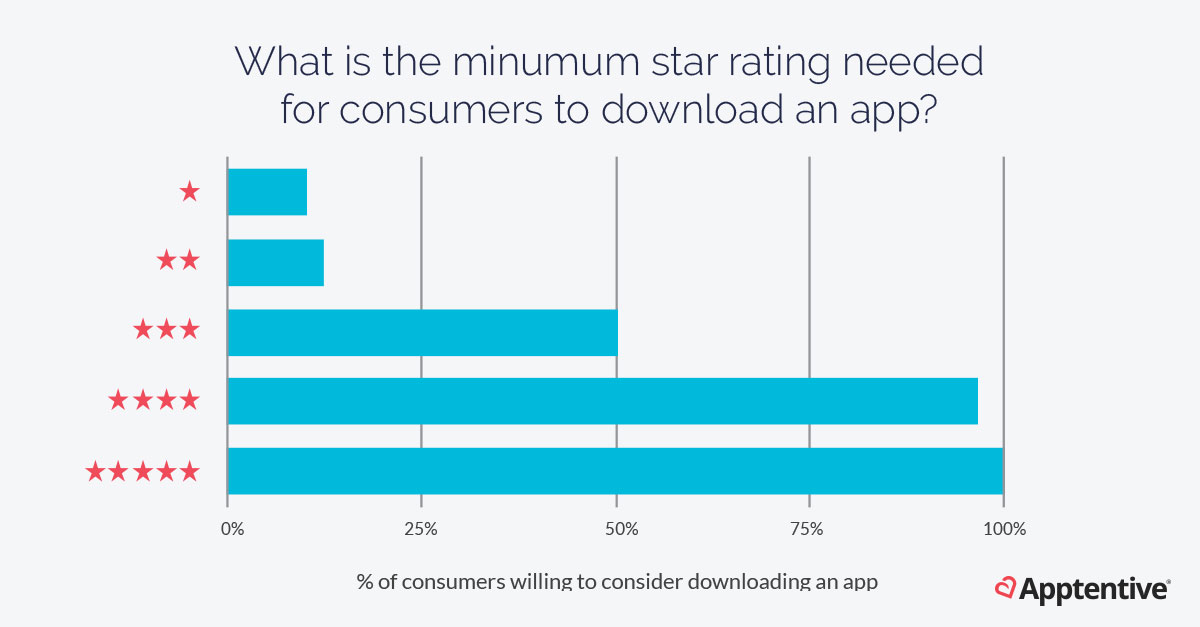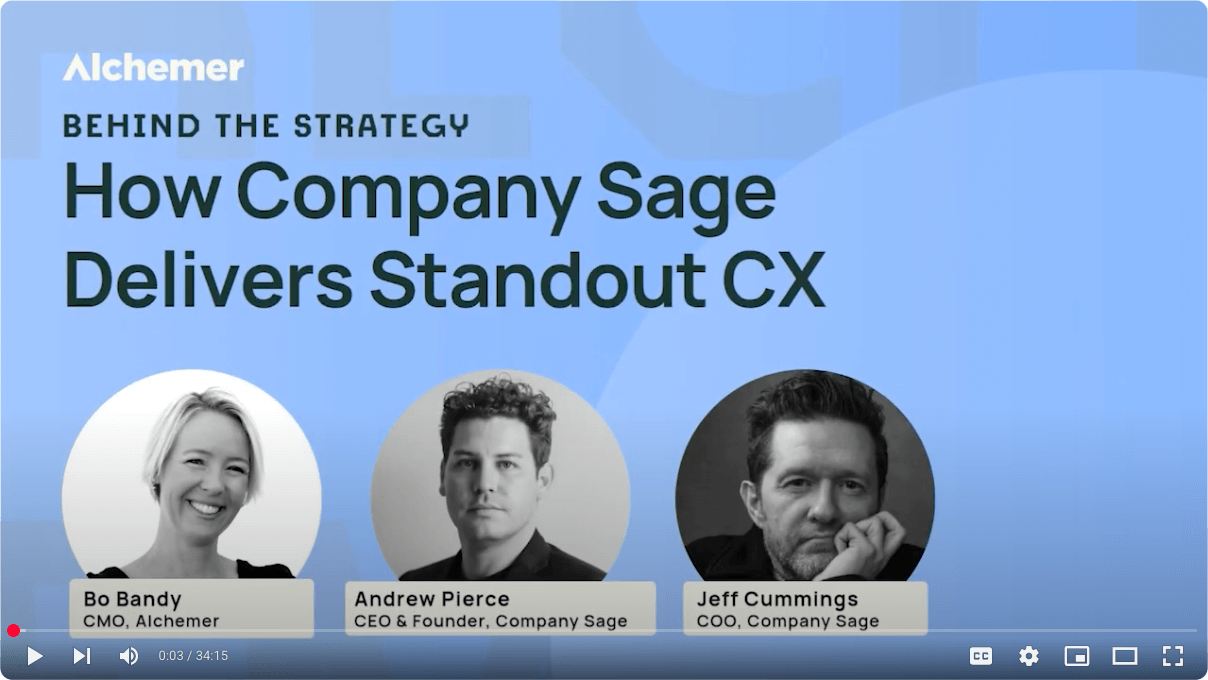Learn how to address negative online reviews and key strategies to earn more positive public feedback from customers.
In this webinar, Robi Ganguly, CEO and Co-founder of Alchemer Mobile (formerly Apptentive), and Ren Fisher, Director of Marketing at Alchemer Mobile (formerly Apptentive), share key brand reputation management strategies specifically through the mobile marketing lens.
You’ll walk away from this webinar with actionable brand reputation management ideas to implement within your organization immediately.
You’ll learn:
- What brand reputation management is and how it works on mobile channels
- Why mobile apps are an extension of your brand
- The impact of mobile brand reputation
- How to measure brand reputation through your mobile channels
- Tips on addressing negative online reviews and advice on preventing them in the future
- Strategies to improve overall brand reputation management through mobile customer feedback and communication
- How to identify and utilize the right mobile moments with the right audience to drive a desired result
Watch the full webinar, download the slides, or read the transcript below.

Robi: Hello again, welcome. I’m Robi Ganguly, CEO and Co-founder here at Alchemer Mobile (formerly Apptentive). Today, we’re super excited to share information about mobile brand reputation management. This can be fantastic for product managers and mobile marketers alike.
Today I’m joined by Alchemer Mobile (formerly Apptentive)’s Director of Marketing, Ren Fischer. Ren, I’m excited to chat with you about this topic today.
Ren: I’m happy to be here Robi. Before we start, a couple of general housekeeping notes. If you have anything to ask us about the topics covered today, or about customer communication tips in general, please submit your questions in the open-ended Q&A field in Zoom. You can see the Q&A button in the center at the bottom of your screen. And also, we’ve saved quite a bit of time for Q&A at the end. And we want to hear from you. If we run out of time to answer your question, or questions rather, we’ll be sure to follow up with you if you add your name. You can also engage with us on Twitter by following along with our @Alchemer Mobile (formerly Apptentive) accounts live tweets. And we’ll be sharing links to all of the resources covered in the deck today via email, after the webinar. So with that, let’s get started.
Robi: Awesome. So today, what are we gonna do? Well, first, we just covered our introductions, who’s involved. Then we’re gonna be defining and talking about what really is brand reputation management and what’s your brand. And then, we’re gonna get into some challenges and the business impacts. And finally, talking about strategies to improve and manage your brand reputation, particularly with respect to mobile. That’s the core focus today, but we’re gonna be talking about more broad brand reputation management as well. And then, we’re gonna open it up for some Q&A. And as Ren mentioned, we’ll be monitoring social channels throughout. So please ask us questions in the chat or on Twitter, etc.
So let’s start with what is brand reputation. Now, brand reputation is a hotly debated topic. Lots of people have very strong feelings about it because there’s so much work put into what people say, what companies really put out as a message, how they present themselves. And as a result, a lot of times, the emphasis inside of companies is very much on what you are saying, what your company is saying, what your plan of attack is. But this misses the other half of the equation, which is, who is your brand for?

Being able to listen to customers has always been really important in the task of brand reputation management. But today, customers have these devices in their pockets all the time that are allowing them to tell the world around them how they feel. And in particular, they can tell you how they feel. And so, you can get a much better sense of what your real brand reputation is. And that’s what we’re here to really focus on. What has changed with mobile and how can we use it to really accelerate your efforts to increase and understand your brand reputation, and take it to the place where you want it to go?
So let’s talk about this a little bit more through the lens of the challenge. Some of the challenges around brand reputation management that we’re facing today can be addressed by mobile. But we wanna lay out and understand some of these core challenges and see if they resonate with you. One really big area that we see a lot of companies struggling with is a problem that we call the silent majority. And what that is is that most customers of most companies are not really very vocal. They’ll operate on a regular basis, going into your stores, visiting your websites, ordering your services, and they won’t really say much. The problem is that a lot of companies have gotten very good at listening to the people who are very vocal and in the minority. And as a result, their understanding of their brand has started to become really, really defined by a small percentage of your customers, when really the vast majority of your customers make up the silent majority. Ninety-nine percent or more of your customers are not talking to you.
And what we see as being a really huge opportunity for most brands is to take those customers from being silent to being vocal by being proactive. In fact, Alchemer Mobile (formerly Apptentive) has been focused on this problem for nine years, helping companies really identify that silent majority and proactively reach out to them in order to understand what’s going on before they have a problem, and importantly, with respect to brand reputation management, understanding each of the experiences along the way in their journey as a customer to try and understand where you’re doing a great job and where you’re not.


The one area where we’re seeing climbing efficiency, the opportunity to hear from more customers and really understand what’s going on, is actually in context, in-app, proactive communication with customers. When you find customers in their experience, in their mobile apps, on the website, as they’re actually walking through the journey, it’s possible to get much higher response rates around what the sentiment and the emotion in particular around their journey is. And because that set of response rates is climbing year over year, we’re seeing more and more brands really turning to mobile to manage their brand reputation. Because it’s so much more effective in terms of reaching customers, and again, lighting up that silent majority. Moving from a place where 19 out 20 customers aren’t talking to you to perhaps a place where 10 out of 20 customers who are unhappy are talking to you before they leave, is a huge sea change. And that’s one of the reasons why moving into more modern communication channels is really important.

So when there’s a disconnect between these touchpoints, or you don’t have an opportunity to listen and learn to your customers, your entire company is challenged because the measurement of your brand is actually blind to pieces of the experience that are super important. So if you walk into a Starbucks, and you have a poor experience with a barista, and you have no opportunity to tell Starbucks, that doesn’t change the fact that you as a customer had a negative experience. But what it does mean is that Starbucks doesn’t have any insight into that. And so, that’s a real challenge for brands today in measuring their reputation and managing.

So with that, I’m gonna hand it over to Ren to talk some about the impacts.
Ren: Great. Thank you, Robi. Now that Robi has explained the challenges of managing your brand reputation on mobile, I’m going to talk about the impact of what your customers say about your mobile experience and how it actually pertains to their perception of your overall brand. So let’s start… So starting, mobile channels are typically the center of customer-brand interaction today. Almost three-quarters of the 5.5 billion adults in the world own a smartphone. And 90% of smartphone time is actually spent within mobile apps. Also, mobile app revenue continues to grow year over year. Last year, in 2019, we saw 17% growth in mobile app revenue.
So why we’re highlighting this is your most engaged customers and your biggest fans are the most likely to have downloaded your app onto their phone. This segment of your customer base is going to be the most likely to want to give you feedback, to have actionable feedback for you, and they’re most likely to respond to feedback requests. And they’re also most likely to care about what you do with that feedback. They are the core voice of your brand and the key to your brand’s overall reputation across every channel you have. So knowing that so many of your valuable customers are on mobile, and in particular the apps on their phones, it is important to talk about the impact of ratings and reviews on your brand reputation.

And none of this should actually be of any surprise, because reviews influence more than conversion. They also affect your brand’s overall reputation. In the same survey we conducted, over half of respondents said a one star or a two-star app store rating of a well-known brand’s app actually negatively impacted their view of the brand as a whole, while 71% of respondents said a four or a five-star app store rating positively impacted their view of the brand as a whole. And it doesn’t stop there. While 79% of consumers check ratings, they do check ratings and reviews before downloading an app, over half actually check again ratings and reviews before even updating an app. And then 55% check ratings and review before actually making an in-app transaction well after download. This shows that the management of your brand impacts customer retention as well as lifetime customer value, not customer acquisition alone. There’s a true business value of thinking beyond customer acquisition with ratings and reviews. As Robi discussed earlier, the majority of your customers who are going to churn will leave without telling you why, while others will only make a purchase when necessary.
For those of you who have subscription-based apps, this is where, predominately, where you’re going to experience your churn and where you are experiencing churn. And then, on the flip side, your customers who are happy, they’re going to make repeat purchases, growing your revenue. And when you actually have a very dialed in brand experience, you benefit from what we call super fans. These are the folks who are going to do your marketing for you when you’re able to unlock and amplify their voices through public channels such as app stores, through ratings and reviews.

I’ll now hand it over to Robi to discuss our tried and tested recommendations to drive positive brand experiences.
Robi: Awesome. So let’s talk how to solve some of the problems that we’ve talked about today. This is where we get to the mobile piece, right? Because mobile is such a meaningful channel that covers so many humans. At this point in time, about 5.5 billion people have mobile devices, right? There’s a huge opportunity for most companies to start to light up mobile to increase the way in which they’re hearing from their customers. But it’s not just about hearing from their customers and measuring it. It’s about what actions there are. So when we think about what you can do in harnessing the power of mobile, it’s first and foremost being able to listen to pieces of the experience along the way when people are making decisions and to try and figure out the right time and the right place in that experience to listen to the customer, to tap into their emotion, in order to uncover customer needs you might not have considered yet, and precisely target the pieces of the experience that you might be trying to improve.
So what that means is that, for example, when somebody is in the process of registering for the first time, there might be a bunch of friction. And you might see a lot of customers who are dropping out of the funnel. By being able to use precise targeting, you can take customers, only the customers who are in the middle of the journey to register who drop out, and then understand what friction they hit. Or maybe the value proposition wasn’t correct for them. Or perhaps their perception of what information was necessary was that it was too high at that point in time.
Allowing you to really target at the right time and the right place can do a lot to improve your understanding of the places where your brand reputation is enhanced and the places where it’s diminished. And those diminishments should really be priorities for fixes for the company. But they also can be benchmarks. You can measure your improvement over time. Also, when you think about targeting the customer at the right time and in the right place and triggering activities that will allow you to understand their emotion, you can now think about what outputs you get from that data. Because you’ve identified customers who had a great experience, you can then segment those customers with your own first-party data around their emotions and follow up with them later. Oh, they had a great experience in their first time with your app and they’ve registered? Well, that’s a person to follow on their journey and to check in and make sure they’re having a great experience two, three, four visits later. But maybe the customers who didn’t have a great experience in the first opportunity are great opportunities for proactive customer care. Being able to segment your customers upon emotion is one of the byproducts of having a sophisticated targeting engine that allows you to target at the right time and the right place to measure emotion.

One of the companies we work with is a large quick-service retail organization that operates in Canada and the United States. And they have an app that’s wonderful for pre-ordering, for checking out the menu, understanding what are ingredients, finding stores and visiting them. Those are all really great use cases for the app. But then, ultimately, the customer has to show up in person in order to get delivery of the products, so they can get their food to either take home or eat in the store. What that means is there are a whole number of touchpoints that that company is lighting up. And they’re using Alchemer Mobile (formerly Apptentive) to do so. So that they can hear about the experience in the app when they’re maybe visiting the menu or trying to figure out the closest store. But when they get to the store, they can also use the kiosk in order to purchase, to finish their purchase, to pick up their order, or to make a new order.
And then, this customer also has a website. And that website is used by a meaningful number of customers on their mobile devices as well. By putting Alchemer Mobile (formerly Apptentive) in each and every one of those experiences, they’re able to connect the dots and say, you know, “Store 471 is having a hard time serving the chicken sandwich that we have, that’s really popular, at a quick rate, whereas store 572 is doing a great job. How can we compare and contrast? How can we make improvements at store 471 that ensure that every customer who goes there is gonna have a fantastic opportunity to experience what we deliver?”
So when you can think about tying the experiences that you deliver to a customer together across channels, and really tie it to a customer ID, that’s where the power of real-time measurement and mobile really hits the execution path for your entire team. It’s not just about brand reputation management at that point. It’s really about customer experience at an individual level. Further, when you are using mobile and you’re getting in front of a lot of your customers across multiple channels, you will start to identify at scale the people who are your biggest fans. As Ren was talking about, a growth driver for most companies is their evangelists, their super fans.
And when you measure and listen to more of your customers. Instead of 1 out of 20, when you listen to 10 out of 20, or 15 out of 20 customers, you will identify a lot more fans. And you can grow your business by activating them. That can be as simple as having those folks rate you in an app store, or on Google Places, or on Yelp, or as complex as bringing those customers into new beta trials of products that you’re testing out that might not hit the market for the next two years. But you know with your fans, you have a safe audience to learn and listen. And you have an opportunity to give them the gift of being in the know about something that’s coming out.
On the flip side, when you listen to a lot more customers, you’re able to identify those who are unhappy. And before they leave, you can actually win them back. Before they leave, you can talk to them and figure out what problems they have and you can address them. And it’s really, really important. Because customers say, by and large, that when you turn that feedback about things that they did not like into action, they respond very positively. So if you’re able to light up a lot more of your customers before they leave and understand what’s making them happy, and then you can take that data and turn it into actions inside of your company. Even to tell the customer, “I’m sorry and we messed up.” And solve their problem. Or to tell the product team, “Hey, we have a set of problems we actually have to diagnose and go solve.” Taking action around this is the most important thing for customers over the long term health of your brand in order to show that you’re making improvements.

When you put all these pieces together and you listen to a lot more of your customers, powered by mobile, you will see the results that many Alchemer Mobile (formerly Apptentive) customers have seen, which is a much more loyal customer base with much lower churn, higher retention, and much higher LTVs, with a loving customer base that is expanding on the opportunity available with the company overall. Those are the powers of really thinking about brand reputation management through mobile.





